Smart Home System Analysis: The Internet of Things Framework Report
VerifiedAdded on 2020/04/01
|12
|2494
|94
Report
AI Summary
This report provides a comprehensive analysis of the Internet of Things (IoT) within the context of smart home systems. It begins by defining IoT and its growing consumerism, highlighting the desire for automated and efficient home environments. The report then details the IoT framework, including the interaction between various components like a central server, smart appliances (refrigerator, television, air conditioners, lighting), and user interfaces (smartphones). A system analysis examines the role of each device and its contribution to the overall functionality of the smart home. Furthermore, the report identifies and discusses prominent challenges associated with IoT implementation, such as security vulnerabilities, control complexities, usage issues, privacy concerns, and the dynamism of the system components. The conclusion emphasizes the complexity of IoT implementation and the need for careful consideration of these challenges to ensure effective and secure smart home systems.
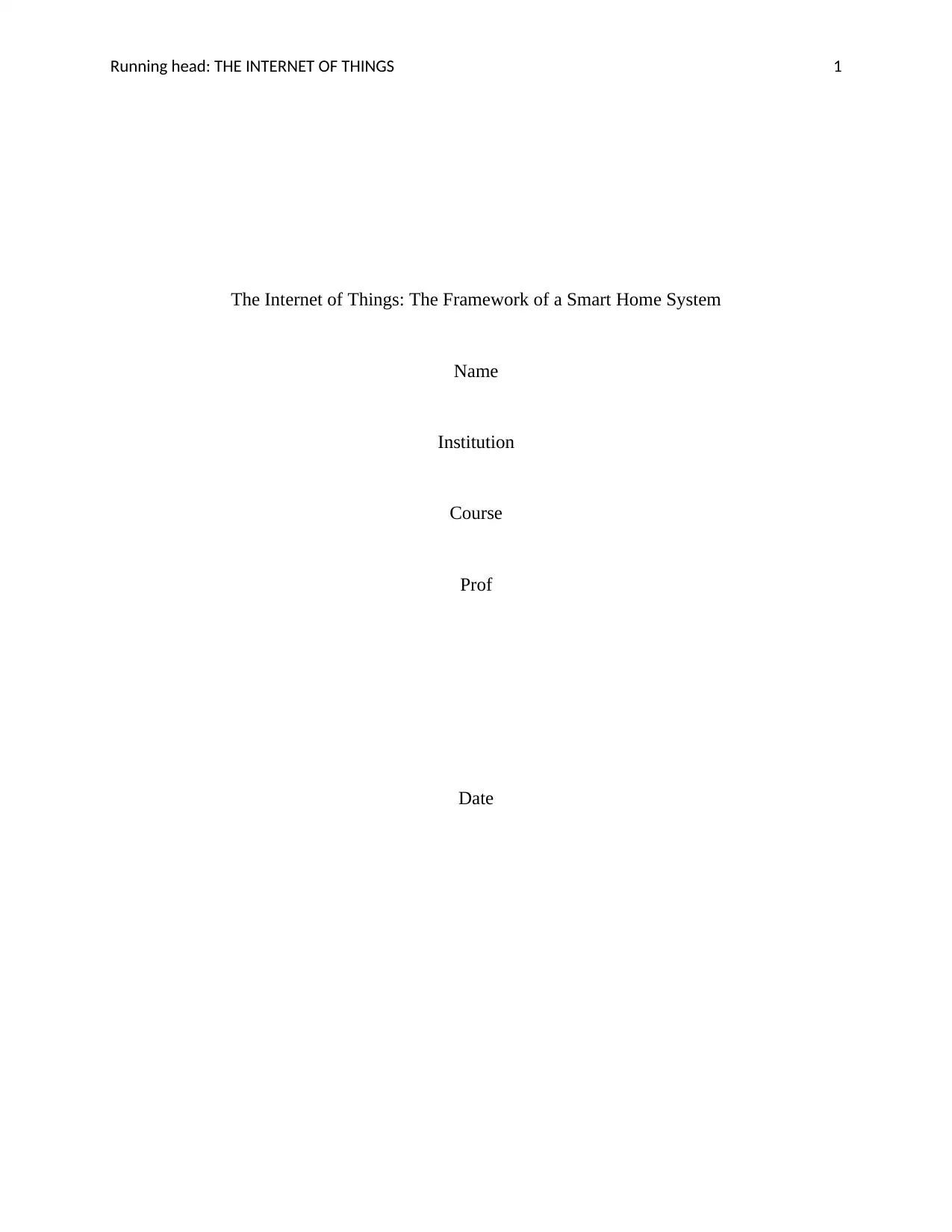
Running head: THE INTERNET OF THINGS 1
The Internet of Things: The Framework of a Smart Home System
Name
Institution
Course
Prof
Date
The Internet of Things: The Framework of a Smart Home System
Name
Institution
Course
Prof
Date
Paraphrase This Document
Need a fresh take? Get an instant paraphrase of this document with our AI Paraphraser
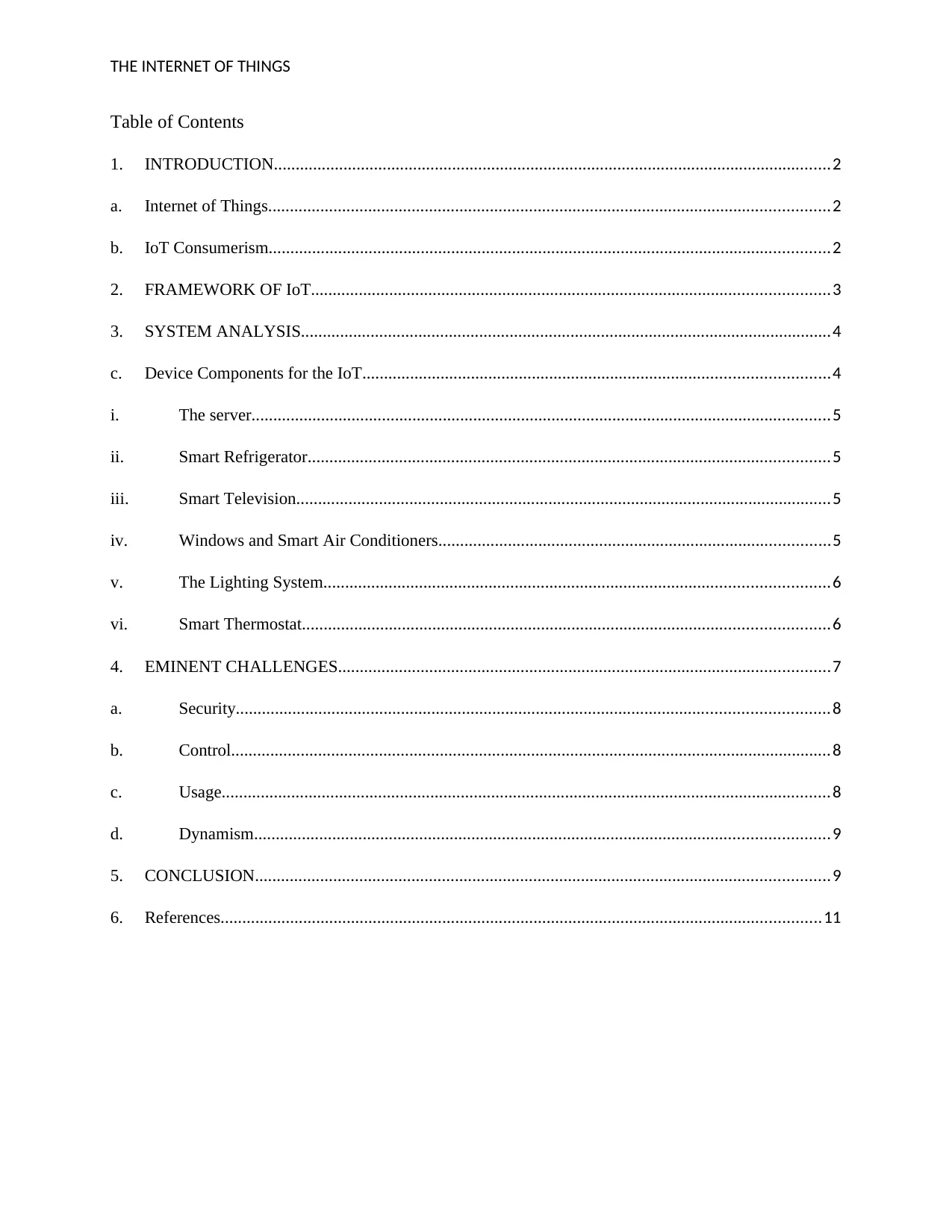
THE INTERNET OF THINGS
Table of Contents
1. INTRODUCTION................................................................................................................................2
a. Internet of Things.................................................................................................................................2
b. IoT Consumerism.................................................................................................................................2
2. FRAMEWORK OF IoT.......................................................................................................................3
3. SYSTEM ANALYSIS..........................................................................................................................4
c. Device Components for the IoT...........................................................................................................4
i. The server.....................................................................................................................................5
ii. Smart Refrigerator........................................................................................................................5
iii. Smart Television...........................................................................................................................5
iv. Windows and Smart Air Conditioners..........................................................................................5
v. The Lighting System....................................................................................................................6
vi. Smart Thermostat.........................................................................................................................6
4. EMINENT CHALLENGES.................................................................................................................7
a. Security........................................................................................................................................8
b. Control..........................................................................................................................................8
c. Usage............................................................................................................................................8
d. Dynamism....................................................................................................................................9
5. CONCLUSION....................................................................................................................................9
6. References..........................................................................................................................................11
Table of Contents
1. INTRODUCTION................................................................................................................................2
a. Internet of Things.................................................................................................................................2
b. IoT Consumerism.................................................................................................................................2
2. FRAMEWORK OF IoT.......................................................................................................................3
3. SYSTEM ANALYSIS..........................................................................................................................4
c. Device Components for the IoT...........................................................................................................4
i. The server.....................................................................................................................................5
ii. Smart Refrigerator........................................................................................................................5
iii. Smart Television...........................................................................................................................5
iv. Windows and Smart Air Conditioners..........................................................................................5
v. The Lighting System....................................................................................................................6
vi. Smart Thermostat.........................................................................................................................6
4. EMINENT CHALLENGES.................................................................................................................7
a. Security........................................................................................................................................8
b. Control..........................................................................................................................................8
c. Usage............................................................................................................................................8
d. Dynamism....................................................................................................................................9
5. CONCLUSION....................................................................................................................................9
6. References..........................................................................................................................................11
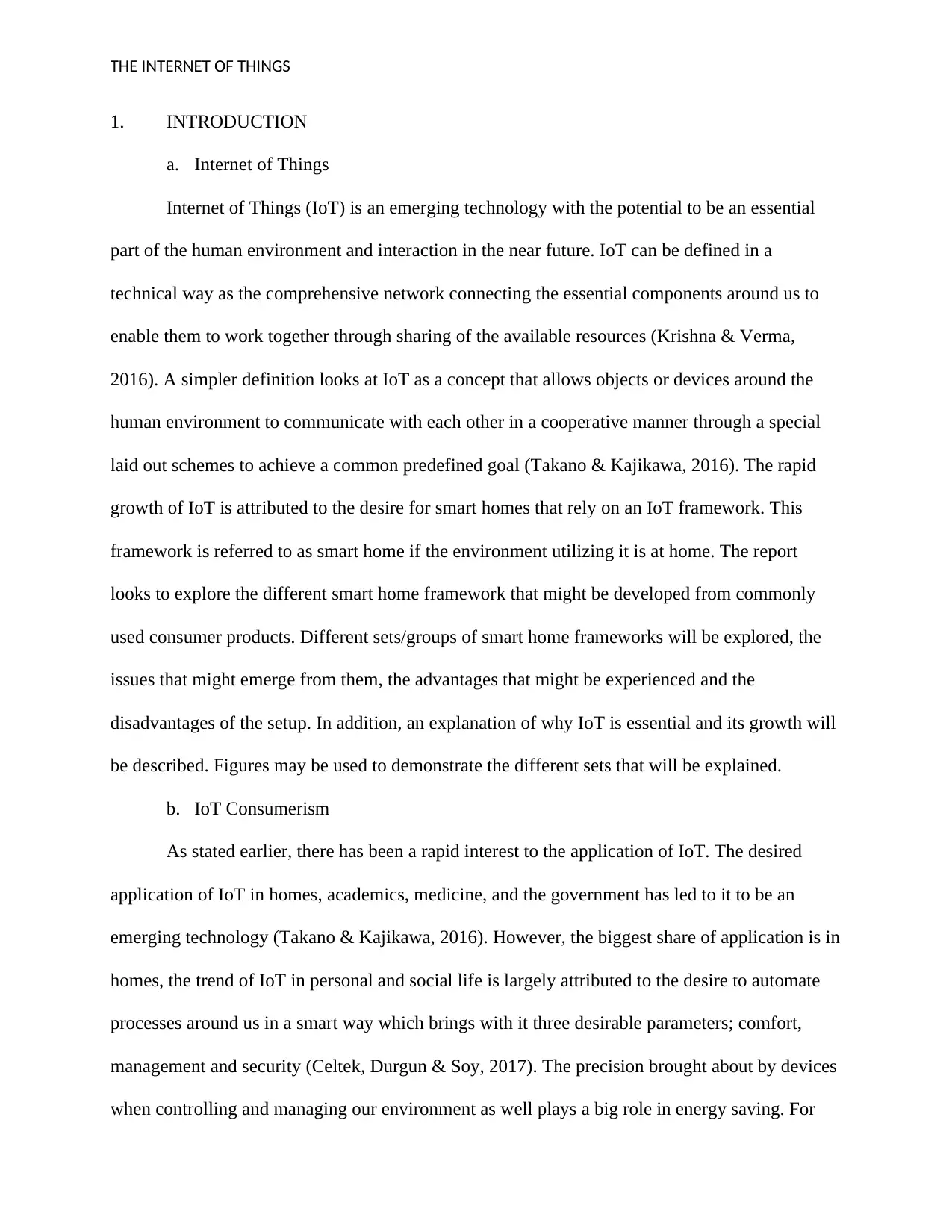
THE INTERNET OF THINGS
1. INTRODUCTION
a. Internet of Things
Internet of Things (IoT) is an emerging technology with the potential to be an essential
part of the human environment and interaction in the near future. IoT can be defined in a
technical way as the comprehensive network connecting the essential components around us to
enable them to work together through sharing of the available resources (Krishna & Verma,
2016). A simpler definition looks at IoT as a concept that allows objects or devices around the
human environment to communicate with each other in a cooperative manner through a special
laid out schemes to achieve a common predefined goal (Takano & Kajikawa, 2016). The rapid
growth of IoT is attributed to the desire for smart homes that rely on an IoT framework. This
framework is referred to as smart home if the environment utilizing it is at home. The report
looks to explore the different smart home framework that might be developed from commonly
used consumer products. Different sets/groups of smart home frameworks will be explored, the
issues that might emerge from them, the advantages that might be experienced and the
disadvantages of the setup. In addition, an explanation of why IoT is essential and its growth will
be described. Figures may be used to demonstrate the different sets that will be explained.
b. IoT Consumerism
As stated earlier, there has been a rapid interest to the application of IoT. The desired
application of IoT in homes, academics, medicine, and the government has led to it to be an
emerging technology (Takano & Kajikawa, 2016). However, the biggest share of application is in
homes, the trend of IoT in personal and social life is largely attributed to the desire to automate
processes around us in a smart way which brings with it three desirable parameters; comfort,
management and security (Celtek, Durgun & Soy, 2017). The precision brought about by devices
when controlling and managing our environment as well plays a big role in energy saving. For
1. INTRODUCTION
a. Internet of Things
Internet of Things (IoT) is an emerging technology with the potential to be an essential
part of the human environment and interaction in the near future. IoT can be defined in a
technical way as the comprehensive network connecting the essential components around us to
enable them to work together through sharing of the available resources (Krishna & Verma,
2016). A simpler definition looks at IoT as a concept that allows objects or devices around the
human environment to communicate with each other in a cooperative manner through a special
laid out schemes to achieve a common predefined goal (Takano & Kajikawa, 2016). The rapid
growth of IoT is attributed to the desire for smart homes that rely on an IoT framework. This
framework is referred to as smart home if the environment utilizing it is at home. The report
looks to explore the different smart home framework that might be developed from commonly
used consumer products. Different sets/groups of smart home frameworks will be explored, the
issues that might emerge from them, the advantages that might be experienced and the
disadvantages of the setup. In addition, an explanation of why IoT is essential and its growth will
be described. Figures may be used to demonstrate the different sets that will be explained.
b. IoT Consumerism
As stated earlier, there has been a rapid interest to the application of IoT. The desired
application of IoT in homes, academics, medicine, and the government has led to it to be an
emerging technology (Takano & Kajikawa, 2016). However, the biggest share of application is in
homes, the trend of IoT in personal and social life is largely attributed to the desire to automate
processes around us in a smart way which brings with it three desirable parameters; comfort,
management and security (Celtek, Durgun & Soy, 2017). The precision brought about by devices
when controlling and managing our environment as well plays a big role in energy saving. For
⊘ This is a preview!⊘
Do you want full access?
Subscribe today to unlock all pages.

Trusted by 1+ million students worldwide
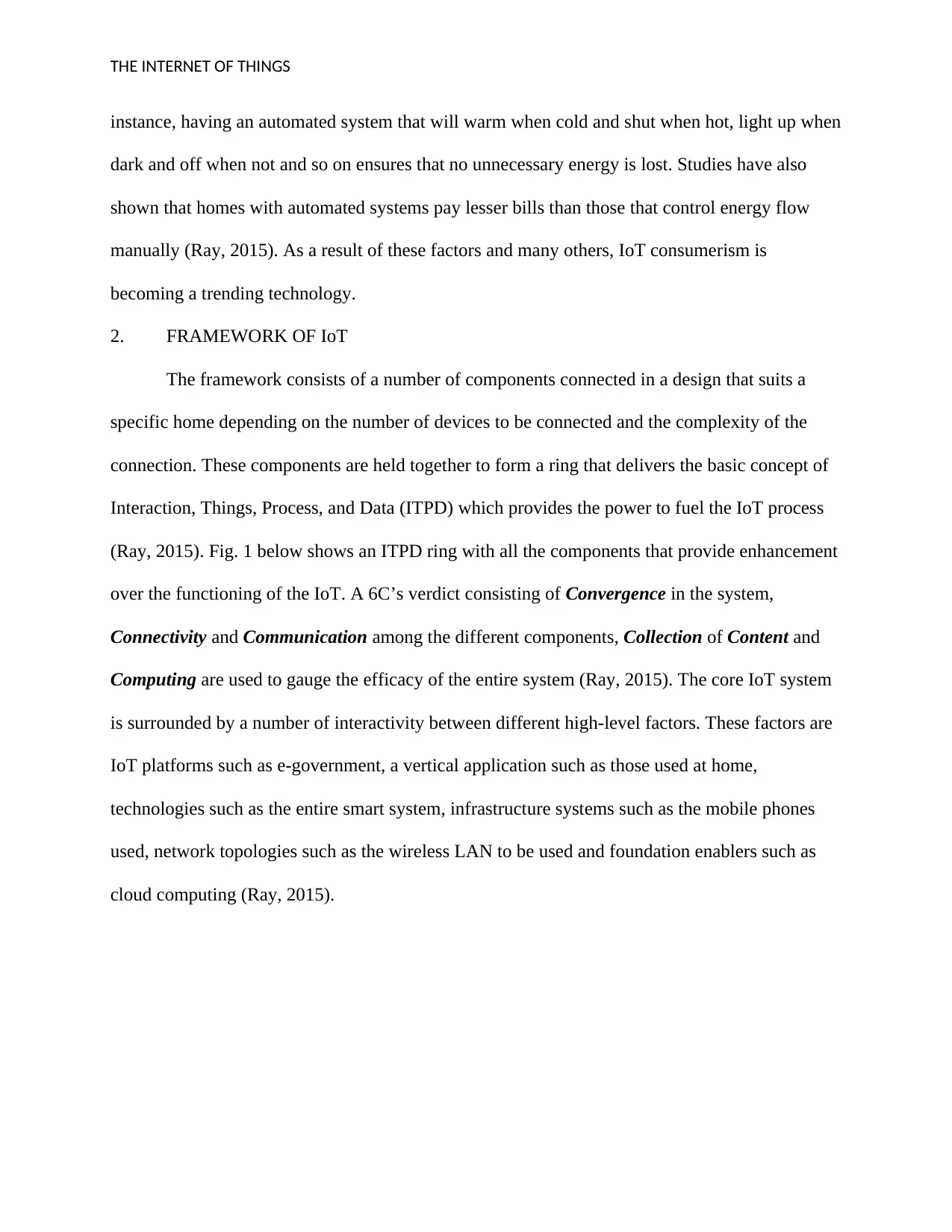
THE INTERNET OF THINGS
instance, having an automated system that will warm when cold and shut when hot, light up when
dark and off when not and so on ensures that no unnecessary energy is lost. Studies have also
shown that homes with automated systems pay lesser bills than those that control energy flow
manually (Ray, 2015). As a result of these factors and many others, IoT consumerism is
becoming a trending technology.
2. FRAMEWORK OF IoT
The framework consists of a number of components connected in a design that suits a
specific home depending on the number of devices to be connected and the complexity of the
connection. These components are held together to form a ring that delivers the basic concept of
Interaction, Things, Process, and Data (ITPD) which provides the power to fuel the IoT process
(Ray, 2015). Fig. 1 below shows an ITPD ring with all the components that provide enhancement
over the functioning of the IoT. A 6C’s verdict consisting of Convergence in the system,
Connectivity and Communication among the different components, Collection of Content and
Computing are used to gauge the efficacy of the entire system (Ray, 2015). The core IoT system
is surrounded by a number of interactivity between different high-level factors. These factors are
IoT platforms such as e-government, a vertical application such as those used at home,
technologies such as the entire smart system, infrastructure systems such as the mobile phones
used, network topologies such as the wireless LAN to be used and foundation enablers such as
cloud computing (Ray, 2015).
instance, having an automated system that will warm when cold and shut when hot, light up when
dark and off when not and so on ensures that no unnecessary energy is lost. Studies have also
shown that homes with automated systems pay lesser bills than those that control energy flow
manually (Ray, 2015). As a result of these factors and many others, IoT consumerism is
becoming a trending technology.
2. FRAMEWORK OF IoT
The framework consists of a number of components connected in a design that suits a
specific home depending on the number of devices to be connected and the complexity of the
connection. These components are held together to form a ring that delivers the basic concept of
Interaction, Things, Process, and Data (ITPD) which provides the power to fuel the IoT process
(Ray, 2015). Fig. 1 below shows an ITPD ring with all the components that provide enhancement
over the functioning of the IoT. A 6C’s verdict consisting of Convergence in the system,
Connectivity and Communication among the different components, Collection of Content and
Computing are used to gauge the efficacy of the entire system (Ray, 2015). The core IoT system
is surrounded by a number of interactivity between different high-level factors. These factors are
IoT platforms such as e-government, a vertical application such as those used at home,
technologies such as the entire smart system, infrastructure systems such as the mobile phones
used, network topologies such as the wireless LAN to be used and foundation enablers such as
cloud computing (Ray, 2015).
Paraphrase This Document
Need a fresh take? Get an instant paraphrase of this document with our AI Paraphraser
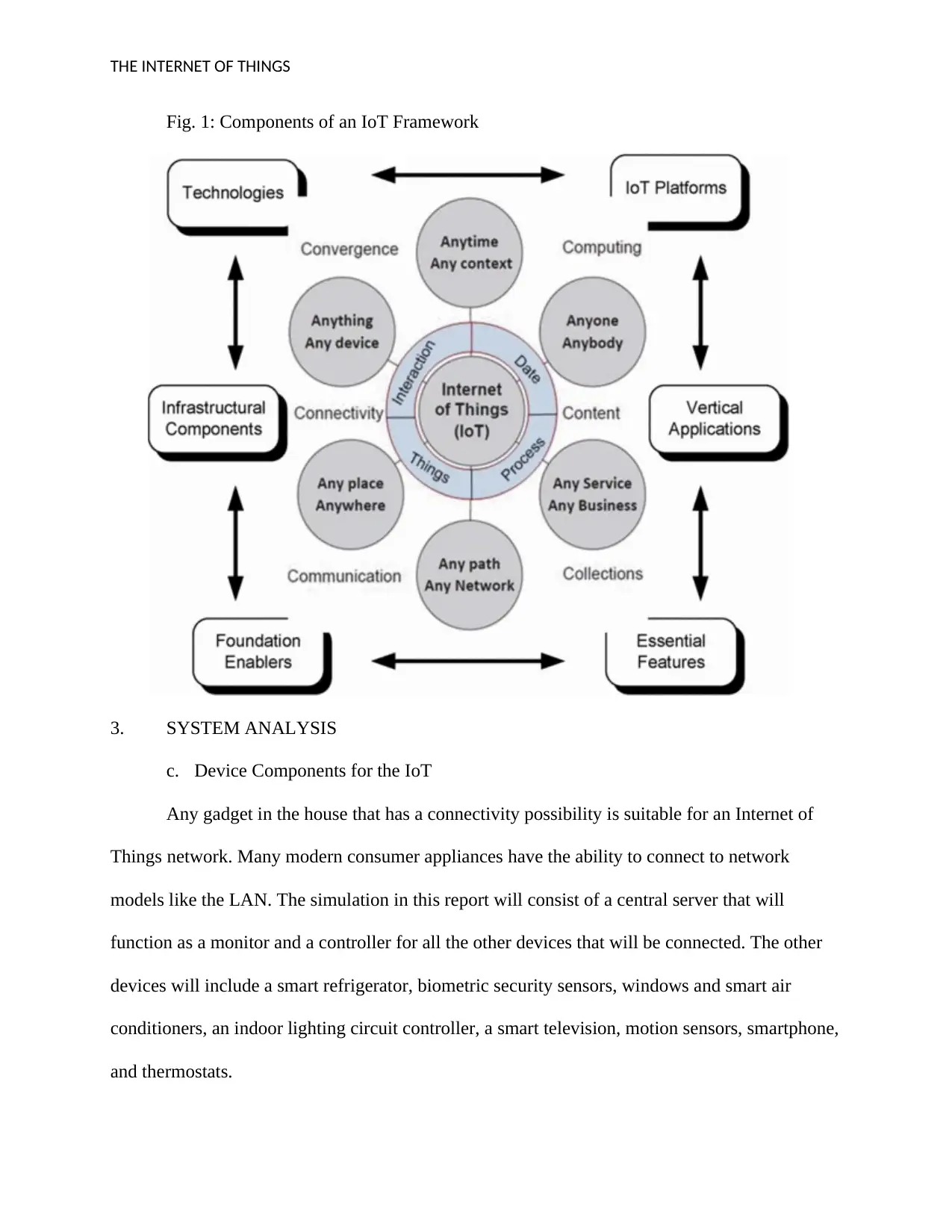
THE INTERNET OF THINGS
Fig. 1: Components of an IoT Framework
3. SYSTEM ANALYSIS
c. Device Components for the IoT
Any gadget in the house that has a connectivity possibility is suitable for an Internet of
Things network. Many modern consumer appliances have the ability to connect to network
models like the LAN. The simulation in this report will consist of a central server that will
function as a monitor and a controller for all the other devices that will be connected. The other
devices will include a smart refrigerator, biometric security sensors, windows and smart air
conditioners, an indoor lighting circuit controller, a smart television, motion sensors, smartphone,
and thermostats.
Fig. 1: Components of an IoT Framework
3. SYSTEM ANALYSIS
c. Device Components for the IoT
Any gadget in the house that has a connectivity possibility is suitable for an Internet of
Things network. Many modern consumer appliances have the ability to connect to network
models like the LAN. The simulation in this report will consist of a central server that will
function as a monitor and a controller for all the other devices that will be connected. The other
devices will include a smart refrigerator, biometric security sensors, windows and smart air
conditioners, an indoor lighting circuit controller, a smart television, motion sensors, smartphone,
and thermostats.
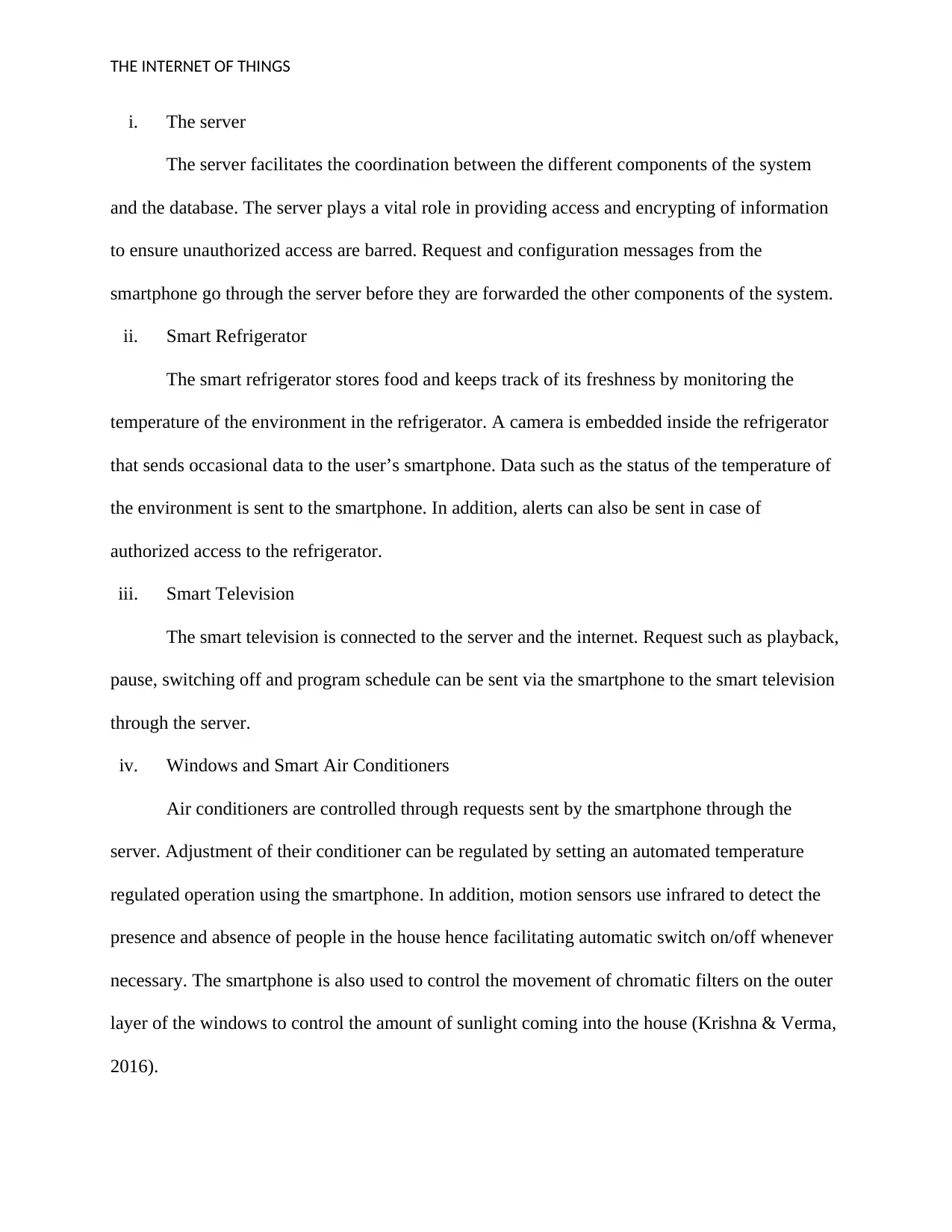
THE INTERNET OF THINGS
i. The server
The server facilitates the coordination between the different components of the system
and the database. The server plays a vital role in providing access and encrypting of information
to ensure unauthorized access are barred. Request and configuration messages from the
smartphone go through the server before they are forwarded the other components of the system.
ii. Smart Refrigerator
The smart refrigerator stores food and keeps track of its freshness by monitoring the
temperature of the environment in the refrigerator. A camera is embedded inside the refrigerator
that sends occasional data to the user’s smartphone. Data such as the status of the temperature of
the environment is sent to the smartphone. In addition, alerts can also be sent in case of
authorized access to the refrigerator.
iii. Smart Television
The smart television is connected to the server and the internet. Request such as playback,
pause, switching off and program schedule can be sent via the smartphone to the smart television
through the server.
iv. Windows and Smart Air Conditioners
Air conditioners are controlled through requests sent by the smartphone through the
server. Adjustment of their conditioner can be regulated by setting an automated temperature
regulated operation using the smartphone. In addition, motion sensors use infrared to detect the
presence and absence of people in the house hence facilitating automatic switch on/off whenever
necessary. The smartphone is also used to control the movement of chromatic filters on the outer
layer of the windows to control the amount of sunlight coming into the house (Krishna & Verma,
2016).
i. The server
The server facilitates the coordination between the different components of the system
and the database. The server plays a vital role in providing access and encrypting of information
to ensure unauthorized access are barred. Request and configuration messages from the
smartphone go through the server before they are forwarded the other components of the system.
ii. Smart Refrigerator
The smart refrigerator stores food and keeps track of its freshness by monitoring the
temperature of the environment in the refrigerator. A camera is embedded inside the refrigerator
that sends occasional data to the user’s smartphone. Data such as the status of the temperature of
the environment is sent to the smartphone. In addition, alerts can also be sent in case of
authorized access to the refrigerator.
iii. Smart Television
The smart television is connected to the server and the internet. Request such as playback,
pause, switching off and program schedule can be sent via the smartphone to the smart television
through the server.
iv. Windows and Smart Air Conditioners
Air conditioners are controlled through requests sent by the smartphone through the
server. Adjustment of their conditioner can be regulated by setting an automated temperature
regulated operation using the smartphone. In addition, motion sensors use infrared to detect the
presence and absence of people in the house hence facilitating automatic switch on/off whenever
necessary. The smartphone is also used to control the movement of chromatic filters on the outer
layer of the windows to control the amount of sunlight coming into the house (Krishna & Verma,
2016).
⊘ This is a preview!⊘
Do you want full access?
Subscribe today to unlock all pages.

Trusted by 1+ million students worldwide
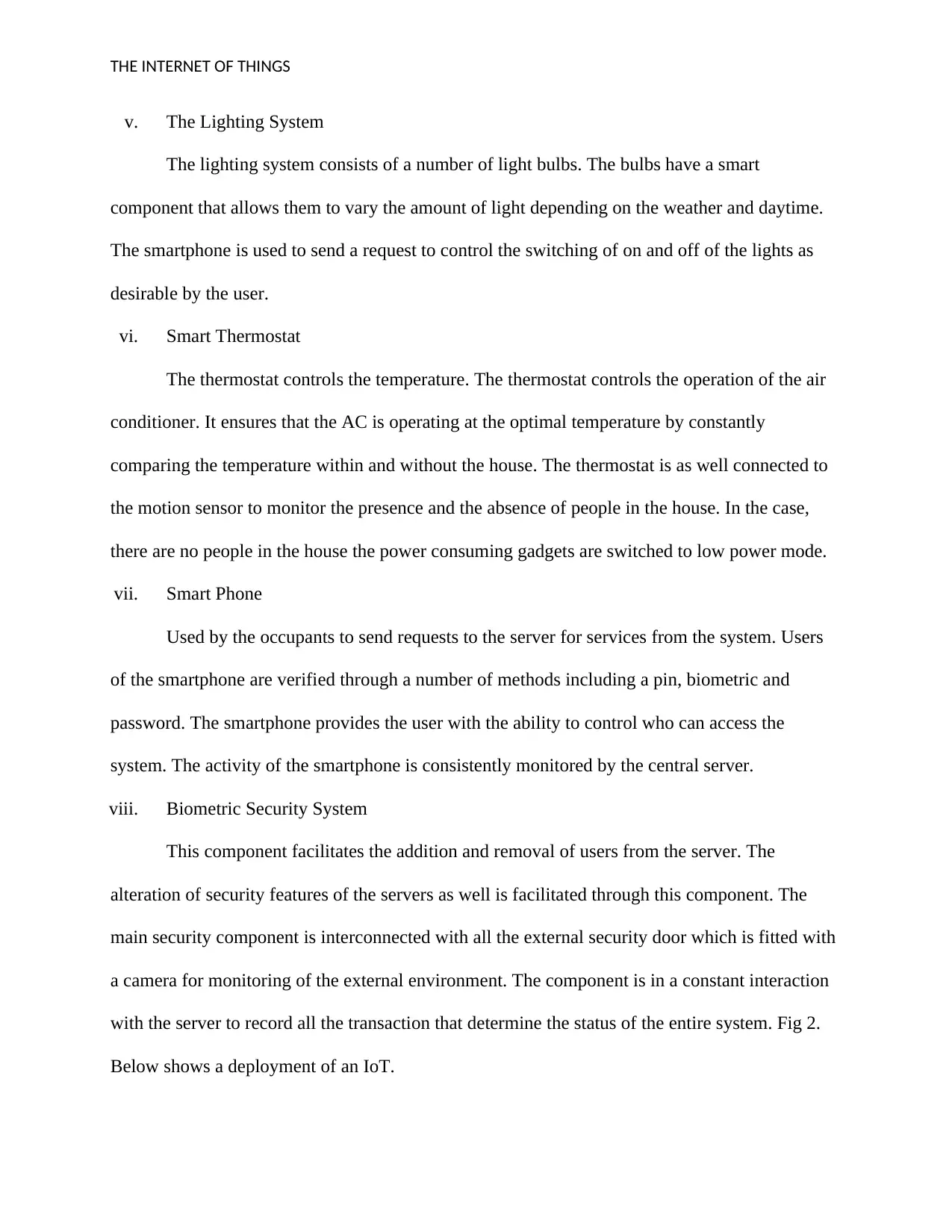
THE INTERNET OF THINGS
v. The Lighting System
The lighting system consists of a number of light bulbs. The bulbs have a smart
component that allows them to vary the amount of light depending on the weather and daytime.
The smartphone is used to send a request to control the switching of on and off of the lights as
desirable by the user.
vi. Smart Thermostat
The thermostat controls the temperature. The thermostat controls the operation of the air
conditioner. It ensures that the AC is operating at the optimal temperature by constantly
comparing the temperature within and without the house. The thermostat is as well connected to
the motion sensor to monitor the presence and the absence of people in the house. In the case,
there are no people in the house the power consuming gadgets are switched to low power mode.
vii. Smart Phone
Used by the occupants to send requests to the server for services from the system. Users
of the smartphone are verified through a number of methods including a pin, biometric and
password. The smartphone provides the user with the ability to control who can access the
system. The activity of the smartphone is consistently monitored by the central server.
viii. Biometric Security System
This component facilitates the addition and removal of users from the server. The
alteration of security features of the servers as well is facilitated through this component. The
main security component is interconnected with all the external security door which is fitted with
a camera for monitoring of the external environment. The component is in a constant interaction
with the server to record all the transaction that determine the status of the entire system. Fig 2.
Below shows a deployment of an IoT.
v. The Lighting System
The lighting system consists of a number of light bulbs. The bulbs have a smart
component that allows them to vary the amount of light depending on the weather and daytime.
The smartphone is used to send a request to control the switching of on and off of the lights as
desirable by the user.
vi. Smart Thermostat
The thermostat controls the temperature. The thermostat controls the operation of the air
conditioner. It ensures that the AC is operating at the optimal temperature by constantly
comparing the temperature within and without the house. The thermostat is as well connected to
the motion sensor to monitor the presence and the absence of people in the house. In the case,
there are no people in the house the power consuming gadgets are switched to low power mode.
vii. Smart Phone
Used by the occupants to send requests to the server for services from the system. Users
of the smartphone are verified through a number of methods including a pin, biometric and
password. The smartphone provides the user with the ability to control who can access the
system. The activity of the smartphone is consistently monitored by the central server.
viii. Biometric Security System
This component facilitates the addition and removal of users from the server. The
alteration of security features of the servers as well is facilitated through this component. The
main security component is interconnected with all the external security door which is fitted with
a camera for monitoring of the external environment. The component is in a constant interaction
with the server to record all the transaction that determine the status of the entire system. Fig 2.
Below shows a deployment of an IoT.
Paraphrase This Document
Need a fresh take? Get an instant paraphrase of this document with our AI Paraphraser
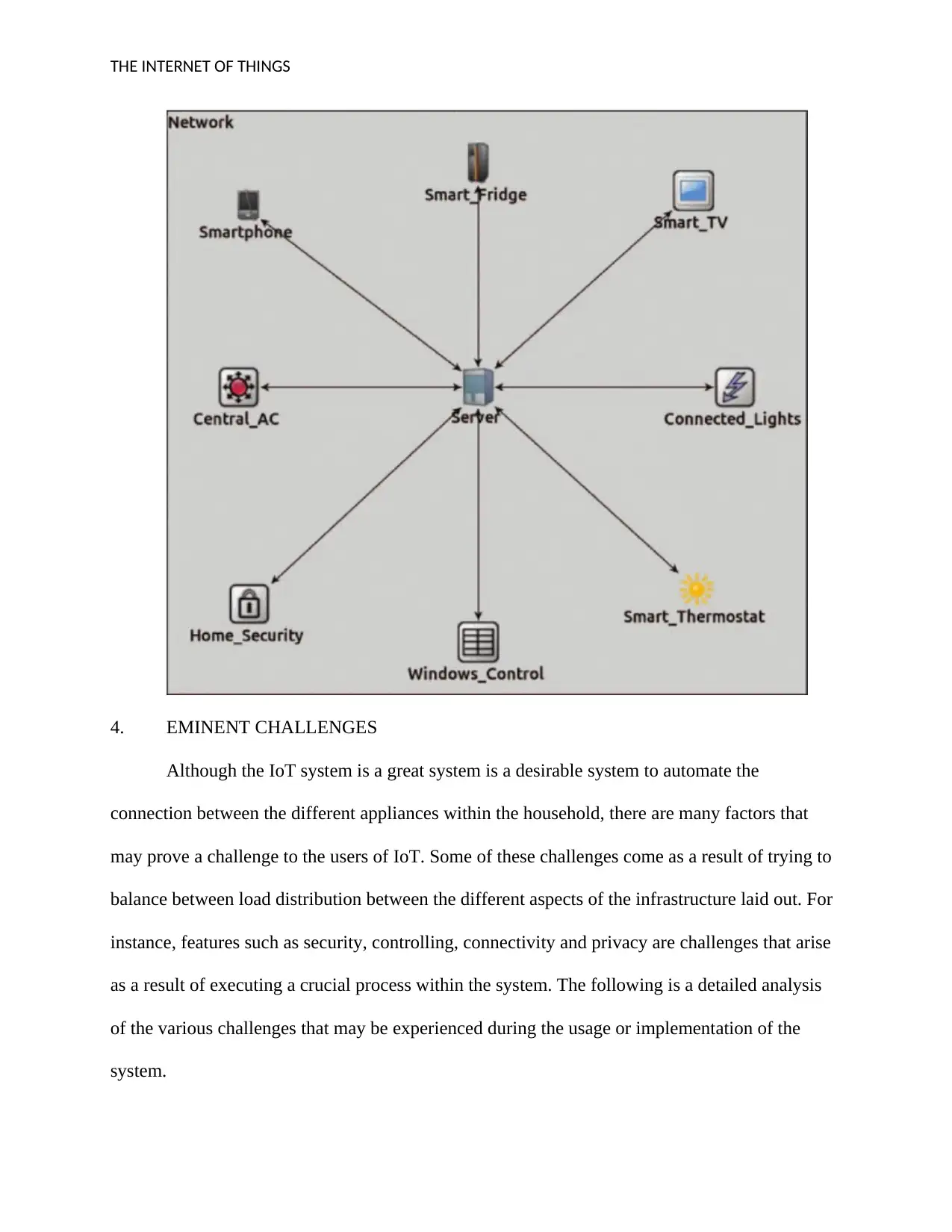
THE INTERNET OF THINGS
4. EMINENT CHALLENGES
Although the IoT system is a great system is a desirable system to automate the
connection between the different appliances within the household, there are many factors that
may prove a challenge to the users of IoT. Some of these challenges come as a result of trying to
balance between load distribution between the different aspects of the infrastructure laid out. For
instance, features such as security, controlling, connectivity and privacy are challenges that arise
as a result of executing a crucial process within the system. The following is a detailed analysis
of the various challenges that may be experienced during the usage or implementation of the
system.
4. EMINENT CHALLENGES
Although the IoT system is a great system is a desirable system to automate the
connection between the different appliances within the household, there are many factors that
may prove a challenge to the users of IoT. Some of these challenges come as a result of trying to
balance between load distribution between the different aspects of the infrastructure laid out. For
instance, features such as security, controlling, connectivity and privacy are challenges that arise
as a result of executing a crucial process within the system. The following is a detailed analysis
of the various challenges that may be experienced during the usage or implementation of the
system.
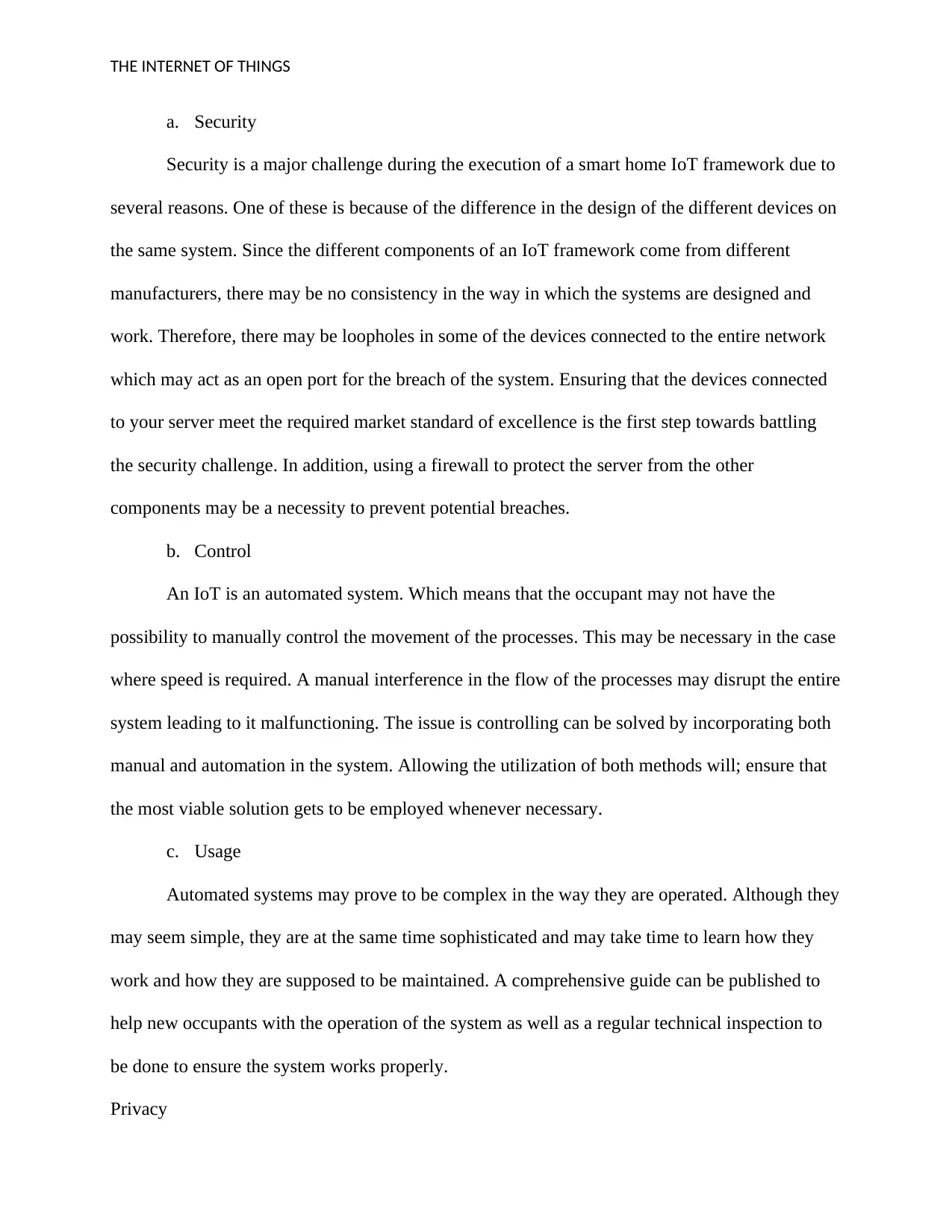
THE INTERNET OF THINGS
a. Security
Security is a major challenge during the execution of a smart home IoT framework due to
several reasons. One of these is because of the difference in the design of the different devices on
the same system. Since the different components of an IoT framework come from different
manufacturers, there may be no consistency in the way in which the systems are designed and
work. Therefore, there may be loopholes in some of the devices connected to the entire network
which may act as an open port for the breach of the system. Ensuring that the devices connected
to your server meet the required market standard of excellence is the first step towards battling
the security challenge. In addition, using a firewall to protect the server from the other
components may be a necessity to prevent potential breaches.
b. Control
An IoT is an automated system. Which means that the occupant may not have the
possibility to manually control the movement of the processes. This may be necessary in the case
where speed is required. A manual interference in the flow of the processes may disrupt the entire
system leading to it malfunctioning. The issue is controlling can be solved by incorporating both
manual and automation in the system. Allowing the utilization of both methods will; ensure that
the most viable solution gets to be employed whenever necessary.
c. Usage
Automated systems may prove to be complex in the way they are operated. Although they
may seem simple, they are at the same time sophisticated and may take time to learn how they
work and how they are supposed to be maintained. A comprehensive guide can be published to
help new occupants with the operation of the system as well as a regular technical inspection to
be done to ensure the system works properly.
Privacy
a. Security
Security is a major challenge during the execution of a smart home IoT framework due to
several reasons. One of these is because of the difference in the design of the different devices on
the same system. Since the different components of an IoT framework come from different
manufacturers, there may be no consistency in the way in which the systems are designed and
work. Therefore, there may be loopholes in some of the devices connected to the entire network
which may act as an open port for the breach of the system. Ensuring that the devices connected
to your server meet the required market standard of excellence is the first step towards battling
the security challenge. In addition, using a firewall to protect the server from the other
components may be a necessity to prevent potential breaches.
b. Control
An IoT is an automated system. Which means that the occupant may not have the
possibility to manually control the movement of the processes. This may be necessary in the case
where speed is required. A manual interference in the flow of the processes may disrupt the entire
system leading to it malfunctioning. The issue is controlling can be solved by incorporating both
manual and automation in the system. Allowing the utilization of both methods will; ensure that
the most viable solution gets to be employed whenever necessary.
c. Usage
Automated systems may prove to be complex in the way they are operated. Although they
may seem simple, they are at the same time sophisticated and may take time to learn how they
work and how they are supposed to be maintained. A comprehensive guide can be published to
help new occupants with the operation of the system as well as a regular technical inspection to
be done to ensure the system works properly.
Privacy
⊘ This is a preview!⊘
Do you want full access?
Subscribe today to unlock all pages.

Trusted by 1+ million students worldwide
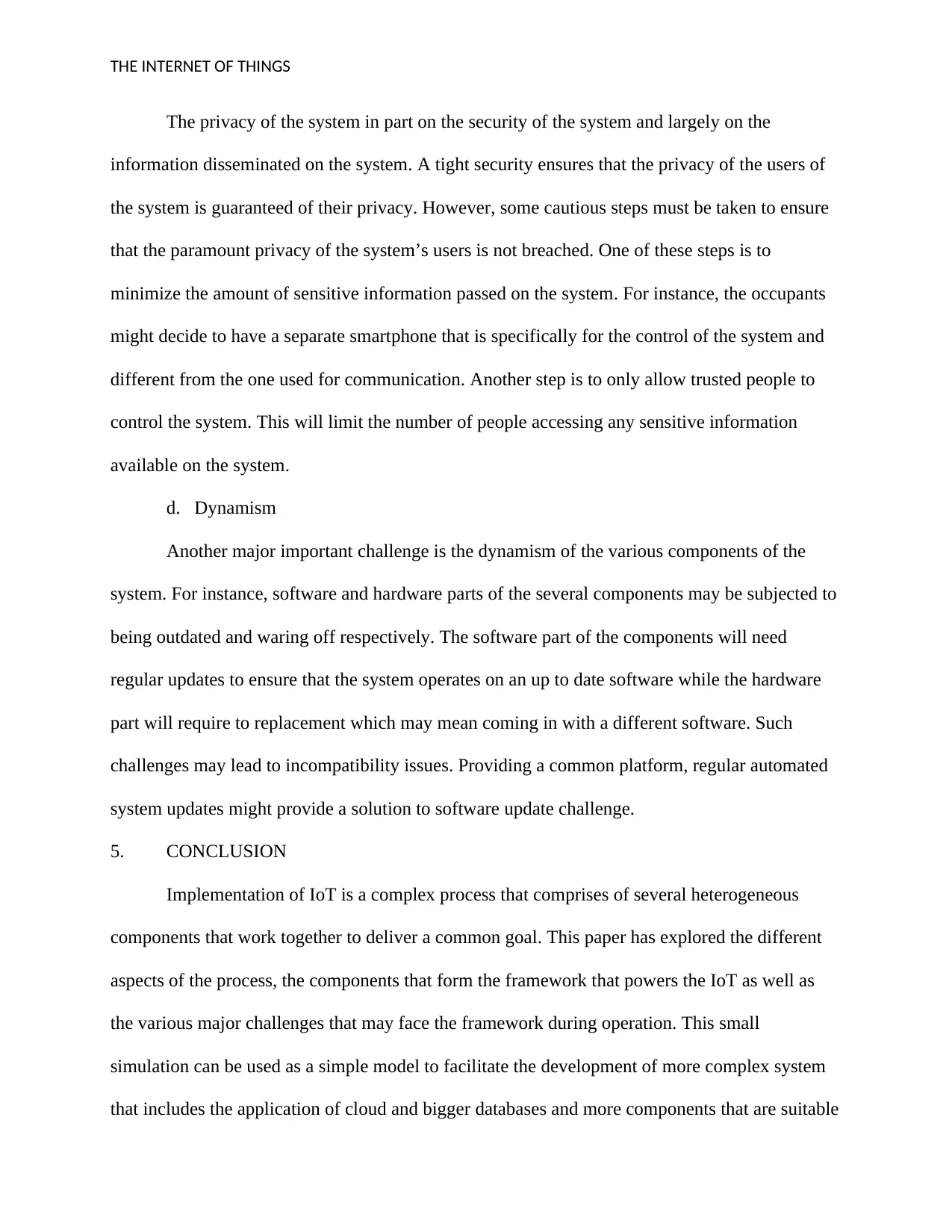
THE INTERNET OF THINGS
The privacy of the system in part on the security of the system and largely on the
information disseminated on the system. A tight security ensures that the privacy of the users of
the system is guaranteed of their privacy. However, some cautious steps must be taken to ensure
that the paramount privacy of the system’s users is not breached. One of these steps is to
minimize the amount of sensitive information passed on the system. For instance, the occupants
might decide to have a separate smartphone that is specifically for the control of the system and
different from the one used for communication. Another step is to only allow trusted people to
control the system. This will limit the number of people accessing any sensitive information
available on the system.
d. Dynamism
Another major important challenge is the dynamism of the various components of the
system. For instance, software and hardware parts of the several components may be subjected to
being outdated and waring off respectively. The software part of the components will need
regular updates to ensure that the system operates on an up to date software while the hardware
part will require to replacement which may mean coming in with a different software. Such
challenges may lead to incompatibility issues. Providing a common platform, regular automated
system updates might provide a solution to software update challenge.
5. CONCLUSION
Implementation of IoT is a complex process that comprises of several heterogeneous
components that work together to deliver a common goal. This paper has explored the different
aspects of the process, the components that form the framework that powers the IoT as well as
the various major challenges that may face the framework during operation. This small
simulation can be used as a simple model to facilitate the development of more complex system
that includes the application of cloud and bigger databases and more components that are suitable
The privacy of the system in part on the security of the system and largely on the
information disseminated on the system. A tight security ensures that the privacy of the users of
the system is guaranteed of their privacy. However, some cautious steps must be taken to ensure
that the paramount privacy of the system’s users is not breached. One of these steps is to
minimize the amount of sensitive information passed on the system. For instance, the occupants
might decide to have a separate smartphone that is specifically for the control of the system and
different from the one used for communication. Another step is to only allow trusted people to
control the system. This will limit the number of people accessing any sensitive information
available on the system.
d. Dynamism
Another major important challenge is the dynamism of the various components of the
system. For instance, software and hardware parts of the several components may be subjected to
being outdated and waring off respectively. The software part of the components will need
regular updates to ensure that the system operates on an up to date software while the hardware
part will require to replacement which may mean coming in with a different software. Such
challenges may lead to incompatibility issues. Providing a common platform, regular automated
system updates might provide a solution to software update challenge.
5. CONCLUSION
Implementation of IoT is a complex process that comprises of several heterogeneous
components that work together to deliver a common goal. This paper has explored the different
aspects of the process, the components that form the framework that powers the IoT as well as
the various major challenges that may face the framework during operation. This small
simulation can be used as a simple model to facilitate the development of more complex system
that includes the application of cloud and bigger databases and more components that are suitable
Paraphrase This Document
Need a fresh take? Get an instant paraphrase of this document with our AI Paraphraser
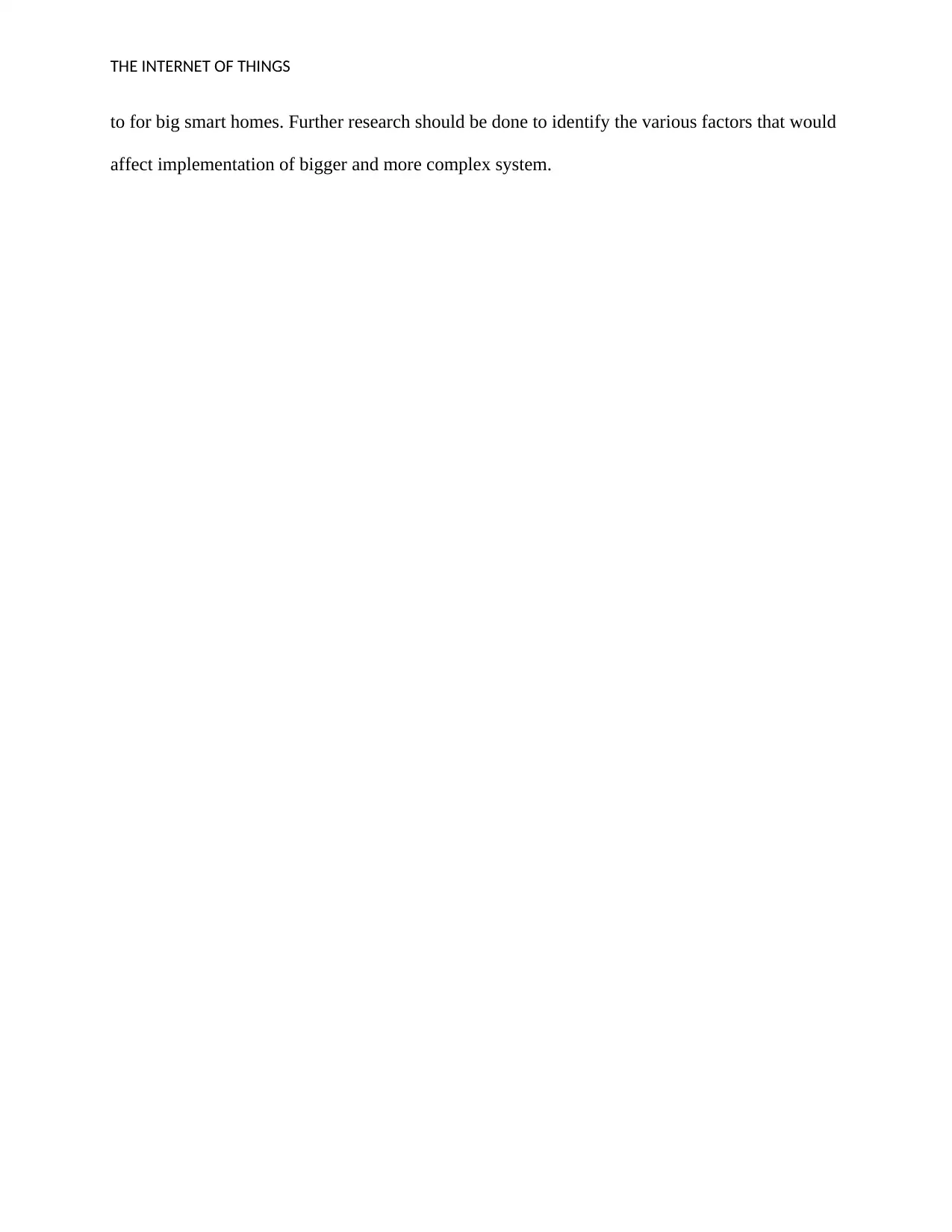
THE INTERNET OF THINGS
to for big smart homes. Further research should be done to identify the various factors that would
affect implementation of bigger and more complex system.
to for big smart homes. Further research should be done to identify the various factors that would
affect implementation of bigger and more complex system.
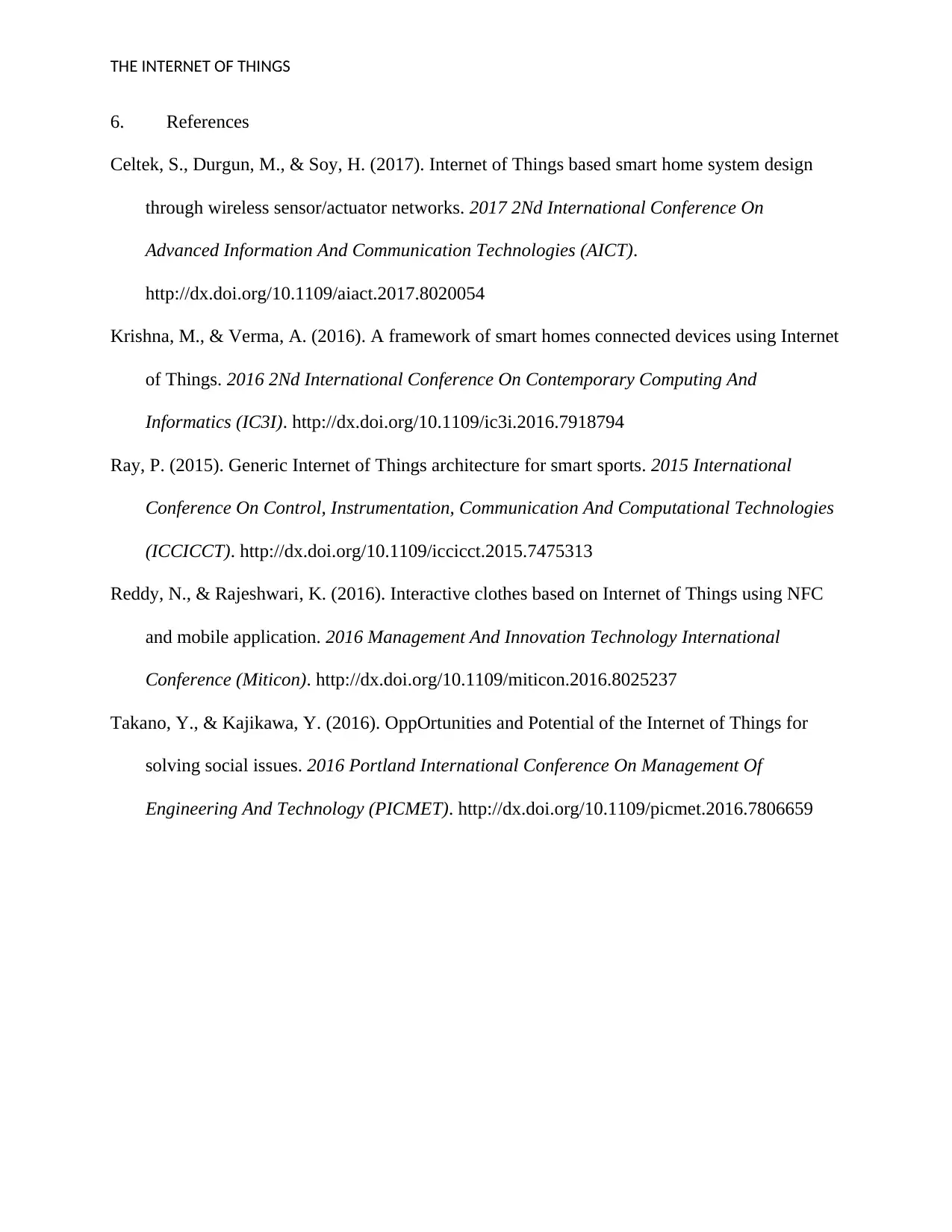
THE INTERNET OF THINGS
6. References
Celtek, S., Durgun, M., & Soy, H. (2017). Internet of Things based smart home system design
through wireless sensor/actuator networks. 2017 2Nd International Conference On
Advanced Information And Communication Technologies (AICT).
http://dx.doi.org/10.1109/aiact.2017.8020054
Krishna, M., & Verma, A. (2016). A framework of smart homes connected devices using Internet
of Things. 2016 2Nd International Conference On Contemporary Computing And
Informatics (IC3I). http://dx.doi.org/10.1109/ic3i.2016.7918794
Ray, P. (2015). Generic Internet of Things architecture for smart sports. 2015 International
Conference On Control, Instrumentation, Communication And Computational Technologies
(ICCICCT). http://dx.doi.org/10.1109/iccicct.2015.7475313
Reddy, N., & Rajeshwari, K. (2016). Interactive clothes based on Internet of Things using NFC
and mobile application. 2016 Management And Innovation Technology International
Conference (Miticon). http://dx.doi.org/10.1109/miticon.2016.8025237
Takano, Y., & Kajikawa, Y. (2016). OppOrtunities and Potential of the Internet of Things for
solving social issues. 2016 Portland International Conference On Management Of
Engineering And Technology (PICMET). http://dx.doi.org/10.1109/picmet.2016.7806659
6. References
Celtek, S., Durgun, M., & Soy, H. (2017). Internet of Things based smart home system design
through wireless sensor/actuator networks. 2017 2Nd International Conference On
Advanced Information And Communication Technologies (AICT).
http://dx.doi.org/10.1109/aiact.2017.8020054
Krishna, M., & Verma, A. (2016). A framework of smart homes connected devices using Internet
of Things. 2016 2Nd International Conference On Contemporary Computing And
Informatics (IC3I). http://dx.doi.org/10.1109/ic3i.2016.7918794
Ray, P. (2015). Generic Internet of Things architecture for smart sports. 2015 International
Conference On Control, Instrumentation, Communication And Computational Technologies
(ICCICCT). http://dx.doi.org/10.1109/iccicct.2015.7475313
Reddy, N., & Rajeshwari, K. (2016). Interactive clothes based on Internet of Things using NFC
and mobile application. 2016 Management And Innovation Technology International
Conference (Miticon). http://dx.doi.org/10.1109/miticon.2016.8025237
Takano, Y., & Kajikawa, Y. (2016). OppOrtunities and Potential of the Internet of Things for
solving social issues. 2016 Portland International Conference On Management Of
Engineering And Technology (PICMET). http://dx.doi.org/10.1109/picmet.2016.7806659
⊘ This is a preview!⊘
Do you want full access?
Subscribe today to unlock all pages.

Trusted by 1+ million students worldwide
1 out of 12
Related Documents
Your All-in-One AI-Powered Toolkit for Academic Success.
+13062052269
info@desklib.com
Available 24*7 on WhatsApp / Email
![[object Object]](/_next/static/media/star-bottom.7253800d.svg)
Unlock your academic potential
Copyright © 2020–2025 A2Z Services. All Rights Reserved. Developed and managed by ZUCOL.



